Things to Make for Your Cat Easy Things to Make for Your Cat
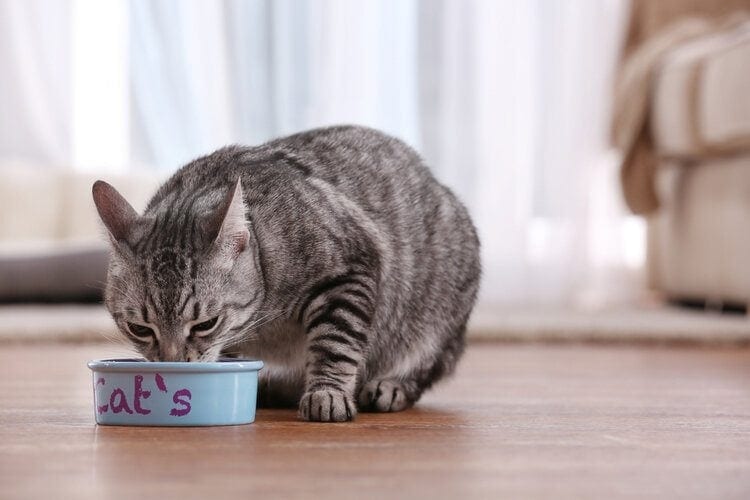
Please note: These 10 recipes were reviewed and approved by Doctor of Veterinary Medicine Claudine Sievert. Our team cooked and tested all these recipes with our cats.
When it comes to a healthy cat diet, it's almost impossible to make it ideal. Whether you use wet or dry cat food, there are always some drawbacks in formulas – these can be ingredients, artificial components, flavors, or texture. Each cat has individual needs, and covering them all with mass-market industrial products isn't always the right decision.
Besides, cats are carnivores – they eat raw meat and don't need grains. This is what many owners forget about when buying kibbles with wheat and corn. As a result, their beloved pets suffer from allergic reactions, stomach upset, sensitivities, poor digestion and metabolism, excessive weight, and so on.
Ideally, a feline diet should consist of what these hunters ate originally – prey and fish. You can help your cat and create an ideal menu for it.
How?
Have you ever tried to make your own cat food? This option would be perfect, and it's not as complicated as it seems. Actually millions of people are already cooking homemade cat food, homemade kibbles, and even homemade kitten formulas themselves!
Below you will find our 10 favorite recipes for homemade cat food.
Top 10 Homemade Cat Food Recipes:
1. Our Favorite Homemade Cat Food Recipe
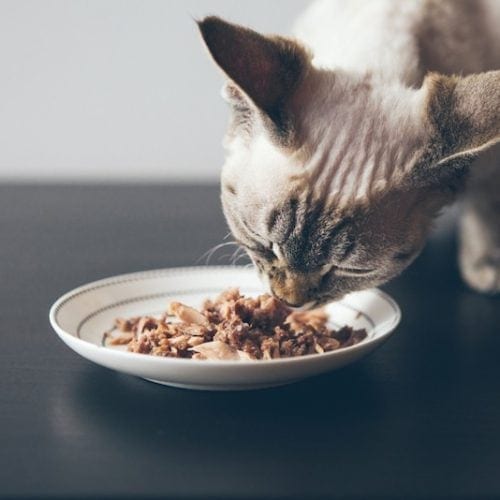
Easy Homemade Cat Food with Chicken and Rice
Here's our easy-to-cook recipe of homemade cat food with chicken and rice! This recipe produces cat food that your kitty will love.
-
Large bowl
-
Spoon
-
Airtight container (for storage)
- 3 oz baked dark chicken meat
- 1/4 cup boiled white rice
- 1/4 cup boiled potato
- 1 teaspoon olive oil
- ⅛ teaspoon Rx Vitamins Nutritional Support
-
Mix all these ingredients together and the meal is ready.
-
Store the leftovers in your airtight container in the refrigerator.
Image credit: Veera, Shutterstock
Calories: 100 kcal
Our Favorite Cat Deal Right Now
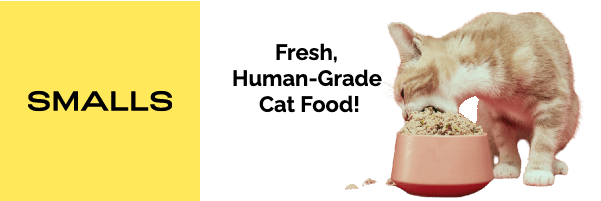
33% OFF at Smalls Fresh Raw Cat Food
Use Code Hepper2022 at Checkout
2. Homemade cat food recipe with beef and rice
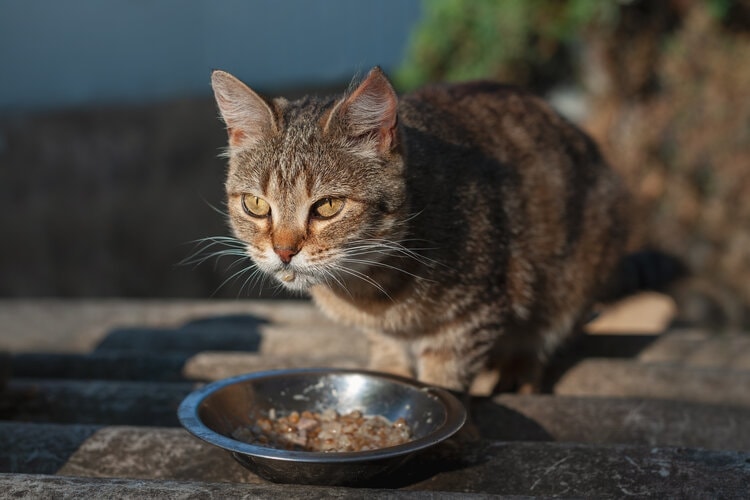
Servings: 3 meals | Calories per serving: 98
Ingredients
- 3 oz boiled beef (avoid seasoning and salt)
- 1/4 cup steam-cooked white rice
- 1/4 cup mashed potato (no butter or salt needed)
- 1 teaspoon sesame oil
- 1/8 teaspoon Rx Vitamins Nutritional Support
Blend all of the ingredients and serve to your happy cat.
3. Homemade cat food recipe with pork and rice
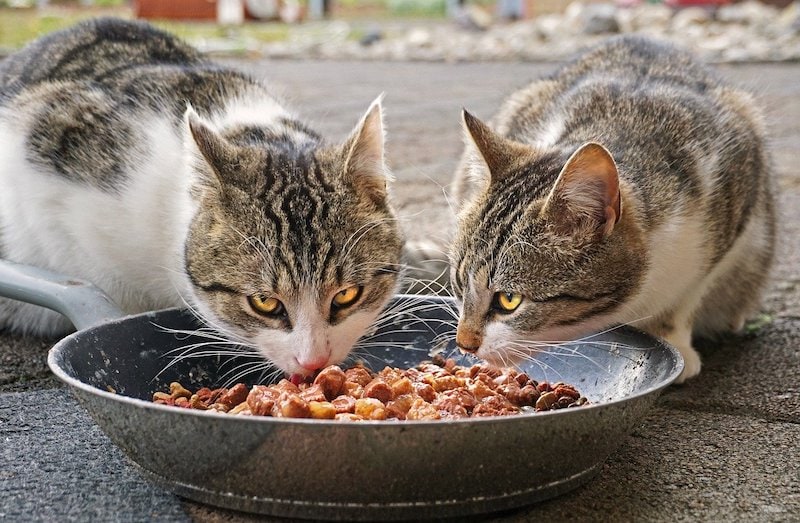
Servings: 3 meals | Calories per serving: 103
Ingredients
- 3 oz oven-cooked pork (avoid fatty pork like jowl, neck, or ribs)
- 1/4 cup cooked wild rice
- 1/4 cup cooked sweet potato
- 1 teaspoon safflower oil
- 1/8 teaspoon Rx Vitamins Nutritional Support
All you have to do is blend these ingredients.
Giving your pet the highest quality nutrition is a top priority, so why not give them a food and water dish to match? The Hepper Nom Nom Bowl is our product, but it's too good not to share.
Made from food-safe stainless steel, you can ensure that your pet is consuming the best nutrition out of the finest bowls on the market. Click here to get yours.
4. Homemade cat food recipe with tuna and rice
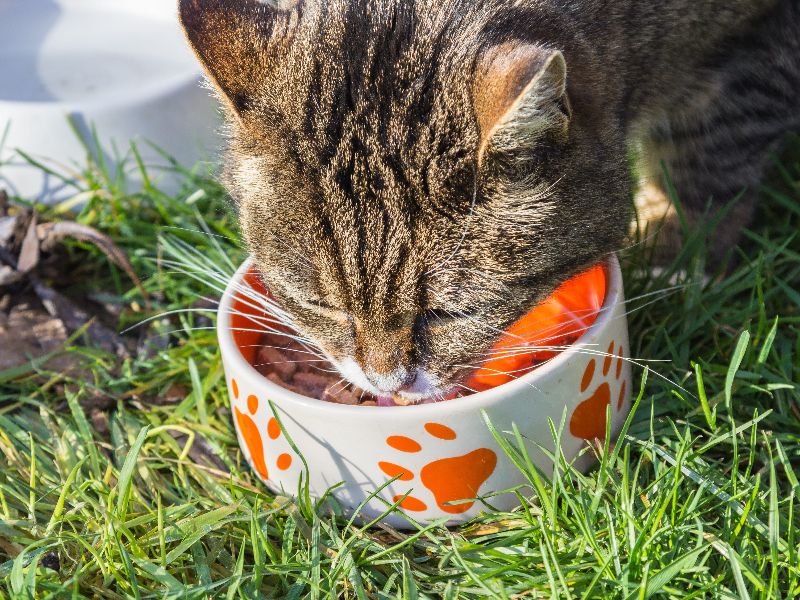
Servings: 3 meals | Calories per serving: 92
Ingredients
- 3 oz canned or boiled tuna
- 1/4 cup cooked white rice
- 1/4 cup mashed sweet potato
- 1 teaspoon fish oil
- 1/8 teaspoon Rx Vitamins Nutritional Support
Blend all of the ingredients and the meal is ready to be served.
5. Homemade cat food recipe with salmon and rice
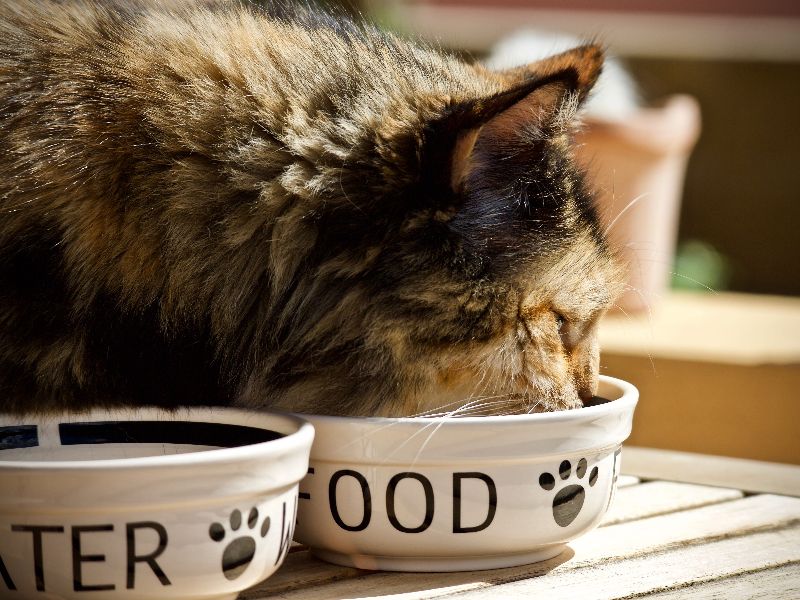
Servings: 3 meals | Calories per serving: 88
Ingredients
- 3 oz steam-cooked salmon (avoid seasoning and salt)
- 1/4 cup steam-cooked brown rice
- 1/4 cup mashed potato (no butter or salt)
- 1 teaspoon olive oil
- 1/8 teaspoon Rx Vitamins Nutritional Support
Blend these ingredients and serve the meal to your cat.
6. Homemade cat food recipe with chicken and oatmeal
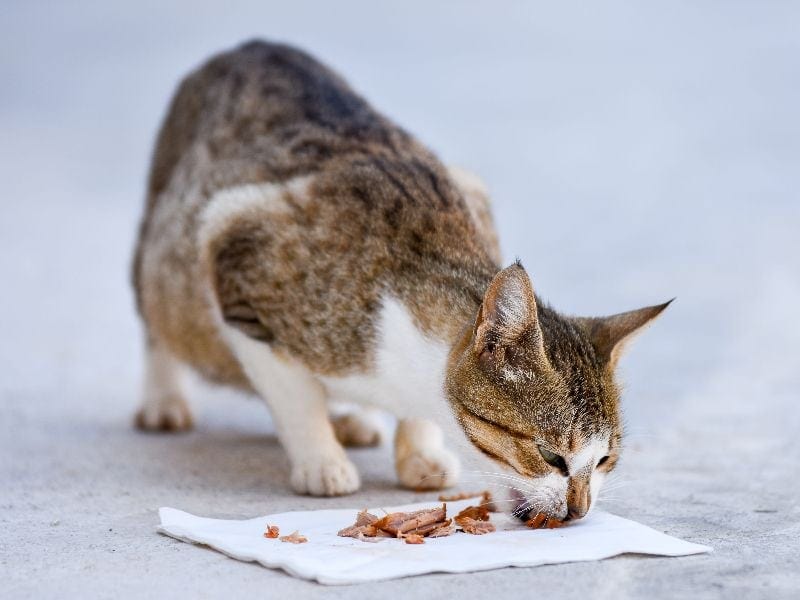
Servings: 3 | Calories per serving: 93
Ingredients
- 3 oz steam-cooked/boiled chicken (dark meat)
- 1/4 cup boiled oatmeal
- 1/4 cup mashed sweet potato
- 1 teaspoon safflower oil
- 1/8 teaspoon Rx Vitamins Nutritional Support
Blend and serve!
7. Homemade cat food recipe with beef and oatmeal
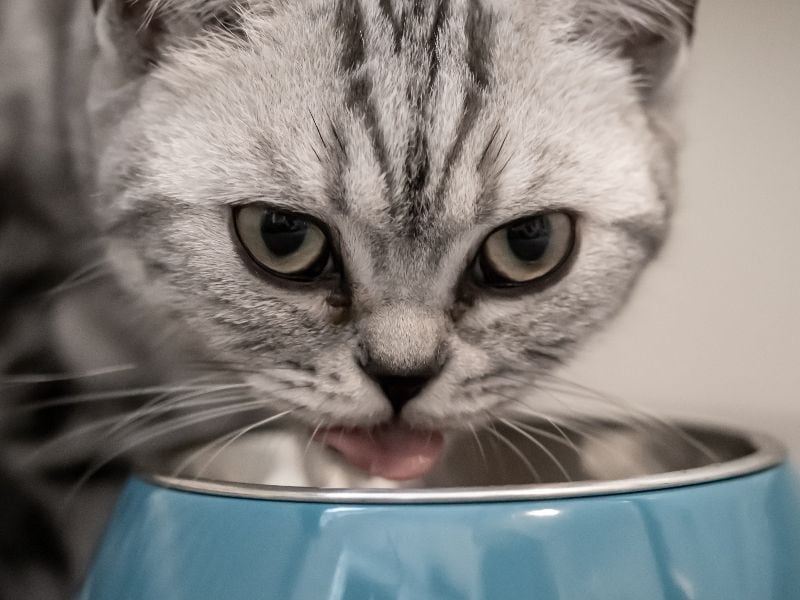
Servings: 3 meals | Calories per serving: 97
Ingredients
- 3 oz boiled beef (no seasoning and salt)
- 1/4 cup boiled oatmeal
- 1/4 cup mashed potato
- 1 teaspoon sesame oil
- 1/8 teaspoon Rx Vitamins Nutritional Support
Mix these ingredients together and serve!
8. Homemade cat food recipe with pork and oatmeal
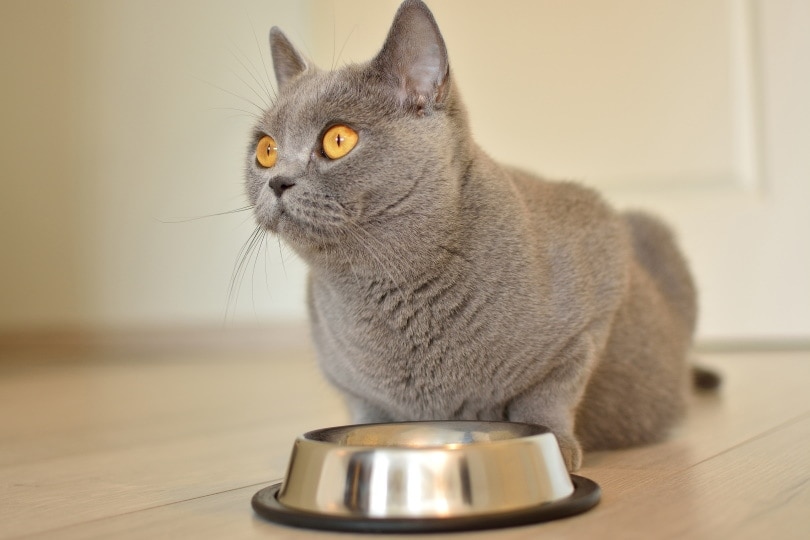
Servings: 3 meals | Calories per serving: 103
Ingredients
- 3 oz steam-cooked/oven-cooked pork (avoid fatty pork)
- 1/4 cup steam-cooked oatmeal (no seasoning or salt)
- 1/4 cup mashed potato (no butter or salt)
- 1 teaspoon sesame oil
- 1/8 teaspoon Rx Vitamins Nutritional Support
Simply stir these ingredients together and serve to your cat.
9. Homemade cat food recipe tuna and oatmeal

Servings: 3 meals | Calories per serving: 92
Ingredients
- 3 oz steam-cooked/canned tuna (no salt/seasoning)
- 1/4 cup cooked oatmeal
- 1/4 cup cooked sweet potato
- 1 teaspoon olive oil (extra-virgin)
- 1/8 teaspoon Rx Vitamins Nutritional Support
Mix the ingredients right before serving the meal.
10. Homemade cat food recipe with salmon and oatmeal
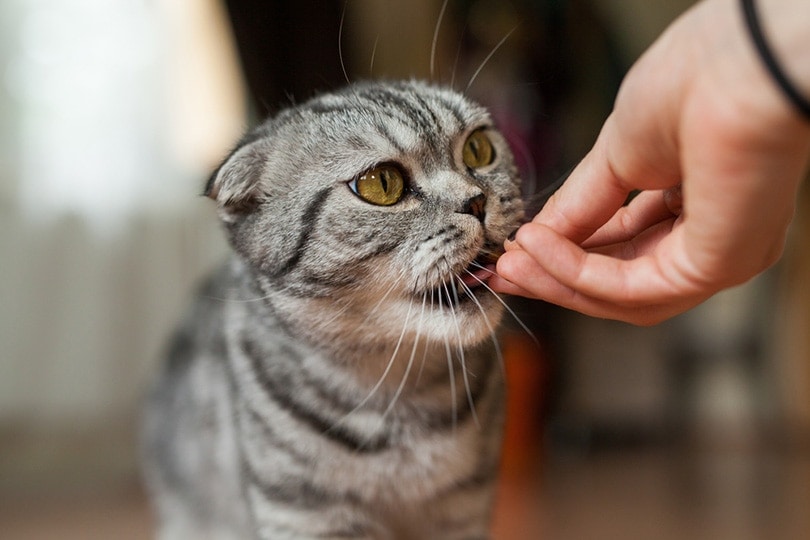
Servings: 3 meals | Calories per serving: 88
Ingredients
- 3 oz steam-cooked salmon
- 1/4 cup cooked oatmeal
- 1/4 cup cooked sweet potato
- 1 teaspoon safflower oil
- 1/8 teaspoon Rx Vitamins Nutritional Support
Mix all of the ingredients. Your cat will be in heaven!
Top 3 Benefits of homemade cat food
If you wonder why to bother making cat food, take into account the following advantages.
1) It's all-natural
Have you ever thought about what makes dry and wet cat food store for so long? Why does it last for a year without changing flavor and properties? Even the best cat foods involve extra processing and adding artificial preservatives. It's not good for a cat's health since many pets are allergic to chemical preservatives and flavors, but the signs of allergy might be even unnoticeable. Besides, homemade food for cats has more natural nutrients, vitamins, and minerals. They are preserved in fresh products and digested quickly.
2) It has pure protein
Dry food has 30-40% protein, while wet cat food has 8-10% protein. Not only do meat and eggs serve as the source of this nutrient – but many manufacturers also add soy and bean products. Those components aren't equally good for all cats. Some pets develop allergic reactions to peas, lentils, and soy.
What else is included in cat food? Manufacturers add plant-based oils, various grains and seeds, and other questionable products that serve as the source of carbs and fats. They might cause various health problems and are not digested efficiently. There's a huge list of other ingredients that are not present in natural cat food recipes. The latter ones allow avoiding potentially dangerous products.
So, if you're not afraid that you won't be able to store the food for a long time or that you will miss a chance to use an automatic feeder – homemade cat food is a great option for you!
- See also:Pure Balance Cat Food Review
Homemade cat food 101: Handy Infographic

A cat bed that's funny and terrifying at the same time? Sign us up! The Hepper Shark Cat Bed lets your cat sleep in cozy comfort -- inside the jaws of a shark! This hilarious novelty bed is our product, and we think you'll like it, too.
Essential nutrients in a cat's diet
What should be included in the cat's recipes? There are several nutrients that must be in any food you serve.
1) Protein
Before you start formulating the recipes when cooking for cats, you should find out how much protein your cat needs. It roughly depends on the life stage, but the average norm should be defined individually with a vet. As a rule, an adult cat needs about 12.5 grams of protein per day. The older a cat gets, the more protein it needs (say, cats aged 10-12 need 6-8 grams of protein per every meal). Vets say that high-protein food is not always the answer. If you serve natural food, include raw meat (chicken, turkey, beef, or rabbit) and eggs – those are the primary source of protein for cats. This is the basics of cat nutrition: by following them, you ensure a proper growth and development of muscles.
2) Fiber
Fiber is important for ensuring healthy digestion and metabolism. When you define how to make cat food, figure out what will serve as the source of fiber. Some cats love eating vegetables, while others chew berries and fruits. Consult with a vet and find out which sources of fiber will be fermentable for a cat – you need to find the products that won't cause gas, diarrhea, constipation, and other adverse effects.
Also, you can consider serving animal-based fibers which are present in the form of ligaments, cartilage, tendons, bones, and fur of prey animals. If your cat is sensitive to both plant- and animal-based fibers, consider switching to wet cat food.
Read more about how fiber affects your cat's health.
3) Fats and carbs
Although fat leads to obesity, it's essential for absorbing vitamins and minerals. Besides, it's used to absorb fatty acids, which are important for reproduction, wound healing, and healthy skin and coat. Besides, fat and carbs both serve as the source of energy.
An adult cat needs about 5 grams of fat per day. When it comes to carbohydrates, there are no exact numbers given, but the science suggests that they should not exceed 2% in food. When you switch to homemade food, both fats and carbs will be contained in meat. If your cat is prone to obesity, choose lean meats like chicken or turkey breast. If your pet is undernourished, it can gravitate towards fatty pieces of meat.
4) Vitamins
Here comes the most challenging part, since it's hard to estimate the amount of vitamins in homemade food. Yet, you should be aware of which vitamins are essential for felines:
- Vitamin A
- Vitamin D
- Vitamin E
- Vitamin K
- Vitamin B1, B6, B12
- Riboflavin
- Folic acid
- Niacin
- Pantothenic acid
- Taurine
How to make sure all of them are present in your cat's diet? Consult with a veterinarian and make up a plan. If some elements lack, you'll need to give vitamin supplements to your pet.
- See also:The CatPet.Club Magazine is Now Part of Hepper
5) Minerals
Here is the list of minerals that should be present in a cat's diet:
- Calcium
- Phosphorous
- Magnesium
- Sodium
- Iron
- Manganese
- Selenium
- Iodine
- Chlorine
- Potassium
- Zinc
- Copper
In the same manner, you should discuss the cat's diet with a veterinarian and find out how to include all of these elements in the food served.
Ingredients to avoid
Now when you decide how to make your cat food, you should consider one more thing: what should be avoided. We know that some manufacturers add products that might be potentially dangerous and allergic to cats.
These include:
- Soy and wheat. Both of them are serious allergens for cats. Some owners don't even notice the signs of allergy caused by wheat-originated gluten, but those can be bothersome for pets (skin irritation, itching, etc.). Do not add wheat fiber to the cat's food – it has the same properties.
- Peas and pea fiber. Although many manufacturers add it as the source of protein, peas have no proven positive effect on the cat's health and might be allergic to some of them.
- Corn. Although corn is rich in protein, many crops are genetically modified. There has been no study on the long-term effect of GMO products on cats' bodies, so it's better to avoid such products.
- Some fruits, veggies, and berries: avocadoes, cranberries, tomatoes, zucchini, red apples. Those might be allergic (the reaction is individual, you should watch your pet's reaction).
- Non-specific meat and meat by-products. Any form of animal matter (organs, skin, fur) is not a good source of protein and fats – there might be an imbalance of these nutrients when a cat eats by-products only.
How to Make Cat Food: A Useful Guide

FAQs
How to get my cat to eat homemade cat food?
It will be easier to switch a cat from canned (wet) food to raw or cooked. Typically, the transition takes about a week. You start serving food in 20/80 ratio, then 40/60, 50/50, and replace the old food gradually. However, the process of transition may take months – don't give up. Some pet owners suggest starting with raw/cooked food treats, such as chicken wings.
What ingredients are in homemade cat food?
Typically, homemade cat food is made of raw meat (chicken, turkey, duck, rabbit, fish, pork, lamb), liver, salmon oil, eggs. Optionally, cat owners add vitamin complexes, salt, potatoes, brown rice, and vegetables/fruits.
How to store homemade cat food?
Usually, it's stored in a refrigerator. Cooked food lasts 24-72 hours since the moment of preparation. If you serve raw meat, you can store meals in the freezer and defrost them before the moment of serving. Frozen food is stored for months without losing its nutrients and properties.
Can I make homemade dry cat food at home?
Yes, it's possible to cook healthy dry cat food at home. Slow-baking technique is the best for this purpose because it allows preserving nutrients and maintaining crispy consistency. The recipes and techniques are described in our separate guide.
How to make a healthy homemade cat food?
You should consider all the aspects of healthy feline nutrition to prepare the recipe that would be a healthy option for your feline friend: the amount of protein, fat and carbs should be thoroughly calculated. Also, the food should contain all the required vitamins, micro- and macro-elements. Please, remember that adding the human spices can be harmful, so you should learn about human foods that are toxic for cats.
At the end of the day
Feline family members have their special nutritional needs – you should consider them when choosing the diet. Cats living on all-natural products are less prone to diseases of the intestinal system and kidneys, not to mention that it allows carnivores to truly enjoy the meals. Now when you know how to make wet cat food, maintaining the proper balance of nutrients becomes simpler. But before you decide to switch your feline friend to raw or cooked meals, it's important to consult a veterinarian – a specialist will help you figure out a perfect formula for your pet.
Featured Image Credit: Africa Studio, Shutterstock
Source: https://www.hepper.com/homemade-cat-food/
0 Response to "Things to Make for Your Cat Easy Things to Make for Your Cat"
Post a Comment